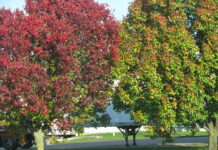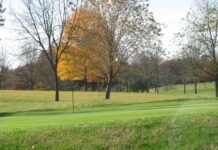Photo credit: DiasporaEngager (www.DiasporaEngager.com).
Results
During days of wildfire smoke occurring during April 30–August 4, 2023, overall observed asthma-associated ED visits¶¶ were 17% higher than expected among all age groups and HHS regions. Increased (excess) asthma-associated ED visits were detected more commonly on days with a higher percentage of air quality monitors reporting PM2.5 concentrations indicative of a wildfire smoke day (Supplementary Table, https://stacks.cdc.gov/view/cdc/132183). Specifically, Region 2 (Figure 1), Region 3 (Figure 2), and Region 5 (Figure 3) experienced the most wildfire smoke days with the highest reported PM2.5 concentrations, the highest percentages of air quality monitors detecting wildfire smoke, and the highest number of excess asthma-associated ED visits.
Region 3 experienced 5 wildfire smoke event days, the highest total amount for any region with more than 1% of air quality monitors reporting AQI ≥101, with a maximum 24-hour average PM2.5 concentration of 259 μg/m3, and Region 2 and Region 5 experienced a total of 4 wildfire smoke event days, with each reporting a maximum 24-hour average PM2.5 concentration of 204 μg/m3 and 216 μg/m3, respectively. Within the identified smoke event days, the percentages of air quality monitors reporting wildfire smoke by HHS region ranged from 0.5%–69.0% (Supplementary Table, https://stacks.cdc.gov/view/cdc/132183).
Region 2 experienced the largest increase in asthma-associated ED visits. During June 6–8, higher-than-expected asthma-associated ED visits occurred for all age groups on 2 days, representing 364 excess visits, and among patients aged 5–17 (2 days, 123 excess visits), 18–64 (2 days, 251 excess visits), and ≥65 years (2 days, 12 excess visits) (Figure 1) (Supplementary Table, https://stacks.cdc.gov/view/cdc/132183). On another day (June 29), wildfire smoke was detected at 2.4% of stations, but no days of higher-than-expected asthma-associated ED visits were detected in any age group (Figure 1).
In Region 3, during June 6–8, 1 day of higher-than-expected asthma-associated ED visits was observed among all age groups combined (179 excess visits), and 2 days of higher-than-expected visits were observed among patients aged 18–64 years (128 excess visits). During June 28–29, no higher-than-expected asthma-associated ED visits were observed (Figure 2). In Region 5 during June 27–29, 1 day of higher-than-expected asthma-associated ED visits was observed among all age groups (172 excess visits) and among persons aged 5–17 years (14 excess visits); among persons aged 18–64 years, 2 days of higher than expected asthma-associated ED visits were observed (155 excess visits).
Regions 1, 4, and 9 each experienced 1 day of wildfire smoke and, within these regions, higher-than-expected asthma-associated ED visits were only observed in Region 4. Region 7 experienced 4 days of wildfire smoke, but asthma-associated ED visits were not increased. In Region 8, 3 wildfire smoke days and 1 day of higher-than-expected asthma-associated ED visits occurred among persons aged 18–64 years, representing 18 excess visits. In Region 10, 4 wildfire smoke days with less than 1% of air quality monitors reporting AQI ≥101 had higher-than-expected asthma-associated ED visits representing 14 excess visits among persons aged 18–64 years.
Source of original article: Centers for Disease Control and Prevention (CDC) / MMWR (Journal) (tools.cdc.gov).
The content of this article does not necessarily reflect the views or opinion of Global Diaspora News (www.GlobalDiasporaNews.com).
To submit your press release: (https://www.GlobalDiasporaNews.com/pr).
To advertise on Global Diaspora News: (www.GlobalDiasporaNews.com/ads).
Sign up to Global Diaspora News newsletter (https://www.GlobalDiasporaNews.com/newsletter/) to start receiving updates and opportunities directly in your email inbox for free.
































